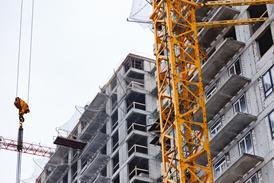The automotive and gaming industries offer useful lessons on how architecture could address global demand for housing, writes Kashif Dafedar

Shelter is one of the main components necessary for human life and for communities to prosper. However, over the last few decades, a rapid population increase, a litany of socio-economic issues and staggering climate change is making it impossible for a large portion of the global population to access decent housing. This is driving a worldwide crisis around good quality, affordable accomodation.
According to a recent United Nations report, the global population will increase from 7.6 billion in 2022 to 8.6 billion by 2030. This will massively increase demand for affordable housing. We are already seeing a global rise in informal settlements and slums, which will continue to increase if we cannot provide more housing and develop faster construction methods. In the UK we see disturbing levels of homelessness and a younger generation often unable to afford rapidly increasing rents and house prices.
Conventional housing design, current construction methods, and supply chain issues fail to address the global demand for affordable housing. The slow and inefficient way in which many architects still work is also a break on innovation.
On the one hand, the cost of desinging and putting together a house is ever-increasing, and, on the other, the global income index is dropping. This widening gap makes it difficult to rely on conventional construction techniques to address the requirements for affordable housing.
We cannot achieve cheaper housing under the current system without significantly compromising the quality of construction, sustainable profits and user satisfaction: aspects necessary to ensure the viability of such efforts.
If architecture only serves a small minority globally, then that means it is failing to address the needs of billions. We need to adopt radically new approaches to design and construction.
Need for innovation
The limitations posed by conventional design processes and construction techniques have led us to investigate alternative approaches to affordable housing. A promising perspective comes from the automotive industry. Cars were once considered a luxury commodity, but now, despite the supply chain issues, they are available at a reasonable cost.
Not only are cars more accessible, but they are also more customisable depending on individual preference or need, from price range to colour and other features. The manufacturing line creates a variety of compatible kit-of-parts, configurable, to create a diverse collection of cars to suit everyone’s needs.
By replicating aspects of the automotive industry’s manufacturing process, we can reduce both the cost of housing units and the time taken for construction. There are numerous benefits to manufacturing architecture as an alternative to on-site construction.
One advantage is the manufacturing work environment is controlled and weatherproof. This environment provides more predictability when it comes to planning a construction schedule and when it comes to the movement and storage of material - which can, very quickly, turn into a logistical nightmare in conventional construction projects.
Computational design & digital architecture
Under a new system, there would only be a handful of core design typologies within each regional housing market. These typologies could be resized, tweaked or added upon to accommodate differing unit layouts and allow for personalisation.
This regional repetition would enable designs and construction processes to become increasingly digitised. Such an approach would enable end-users to customise their units depending on their preferences and constraints.
The process seems quite challenging from the outside, but game designers have been adopting similar approaches for a long time. In a gaming environment, entire cities can be planned using basic modular principles to create buildings, streets, landscaping and street furniture.
No doubt, understanding spatial relations within a habitat and programming them might be a little more complicated than in a game environment, but the principles are quite similar. If we strategise an approach to construction based on modular units and assembly rules, the potential challenges are manageable.
Using computational tools for design can also significantly improve the overall process. Gamification of such methods can encourage users to configure their units and optimise their energy, environmental conditions, views, cost, construction time, etc.
By making digital tools available online and through apps, commoditisation occurs, making accessibility possible even in the most remote parts of the world. A web-based design tool could also take advantage of mobile AR and VR functionality to allow users to accurately render and experience their designs while they customise them further.
Despite our best efforts, it isn’t straightforward to encode the creative component of building design. However, there are multiple potential benefits, including encoded regulations, sustainability practices, and local codes. And like any customisation tools available on most car sale websites, digitised, customisable architectural layouts are possible.
Ambitious users can try designing the units from scratch with the tool being smart enough to offer design assistance and to help avoid obvious blunders. The combination of construction innovation and computational design has the potential to democratise architecture and minimise the cost margin on design services to negligible amounts.
Suppose we manage to navigate the industry towards a more modular market. In that case, we might be able to address numerous global issues that concern human habitat. Such as in developing countries where informal settlements are often accompanied by a myriad of issues around construction quality and sanitation, or cities where gentrification is transforming the urban canvas in favour of a select few.
There are also potential applications in contexts where ever-increasing natural calamities and geopolitical instabilities have pushed large parts of the population towards refugee status and homelessness.
Modular housing, rapid construction and computational design could help provide individuals, communities and governments of the world with access to affordable housing: an area that is in desperate need of innovation.
Postscript
Kashif Dafedar is an associate at Arcadis
















5 Readers' comments